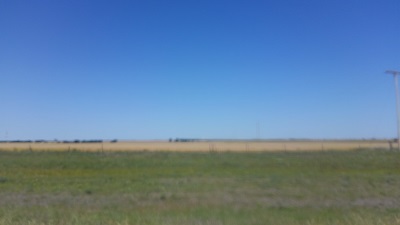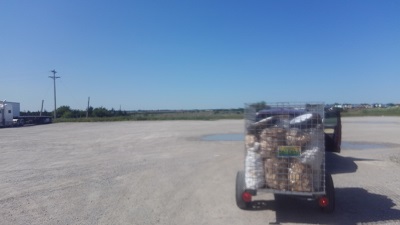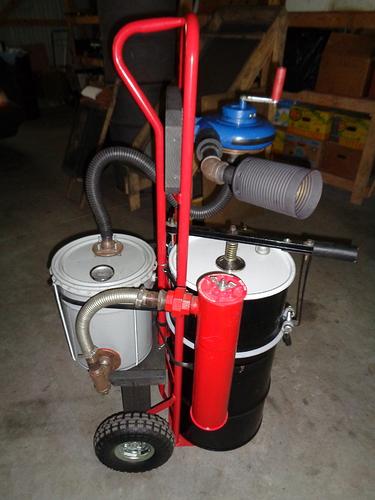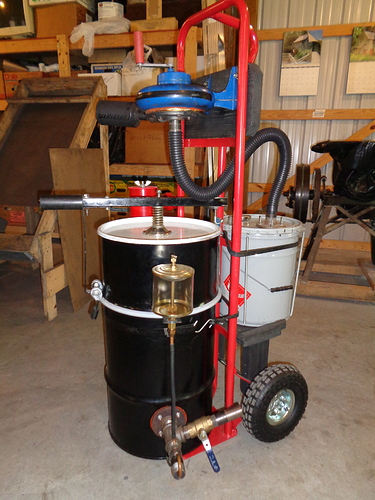Decided to start a new topic for new stuff. The planning part is done. Feel free to post anything from past meetups, or what you are now doing project and travel wise that would be of interest.
Well I know it is not woodgas related but it is the traveling I am doing instead of going to Argos.
 !
!
Kansas wheat as far as I can see.

Caught a few small large mouth Bass and some blue gill.

Traveling out sitting at a truck stop in Kansas
Nice looking blue sky, how far are you driveing on wood this time.? Interesting wood gas travel.
Here is my initial small contribution to Virtual Argos 2020:
Inspired by Gary Gilmore once again, I took my 16 gallon SimpleFire charcoal gasifier and made it portable, using a hand truck. The hand-cranked starting blower can be easily removed for attaching to the gas line near the engine carburetor, if desired. This is the same gasifier I have used to run my grist mill and electric generator previously. Bungee cords currently hold most of it together with a metal strap around the reactor.
Thanks for the wood gas drive up the mountain roads jakob, nice country.Your dakota looks good. The walk around of your dakota showed the excelent tallent you have learned welding and fabrication work, real nice build. i want too build a ss gasifier too, it makes the unit look much better Quallity .NICE JOB.
Hi Jacob.
Seemed to be steep slopes where you drove, I am very jealous of you who can only ride without hassle.
Do you know how much wood you make over per mile, about?
Would also like to know how big your throttle is and what diameter of the pipe where the nozzles are located?
I have problems with hanging and with the heat in my car.
I get just under a pound per mile about and I get better than that on highway and if I pour my charcoal back in the top. The main difference I have found between mine and most everyone else’s is that on long trips I get plugged up not to loose. Mine is a very good charcoal retort. I sometimes take the charcoal i take out and put it back in the top so that increases mileage but takes more work. The fire tube is a 14 inch octagon then it has heat sinks welded on the outside of that. so it is an actual 12 inch space between the nozzles. My restriction is about 8 1/2 inches in diameter. Tube is 18 inches long. grate runs about 1600 degrees F on normal operation. It is the typical dodge Dakota throttle body I think there are two, about 2 inches in diameter. I feed it with one 3 inch pipe for gas and one 2 inch pipe for air I have flooded it before it is good to have two air valves.
That’s interesting Jacob. Do you have any idea why? What have you done differently?
With both my gasifiers I get too loose after about half an hour of open road driving. Rail vacuum lowers, hopper vacuum climbs, rail temp climbs and I back off a bit. I guess pulling oxygene deep down consumes all the fines and I’m left with only coarse char.
Nice trip btw.
It seems the fire tube and choke plat may be too large . Difficult to reduce the diameter of the fire tube but very easy to reduce the diameter of the choke plate .
Thanks For the thoughts I am going to have to pull the hopper off to fix an air leak I will put in a smaller choke plate then. What size would you say is best I want it for highway I don’t care to much about Idling.
Thanks Jacob.
Very interesting I think a WK looks different than mine, my narrowing is only 4 ", think it is small for this engine, but at the same time I want to run at idle.
I also think my fire tube is too small, only 9 ".
Wonder if the size of nozzles does not affect the size of the carbon, smaller nozzles will well blow the carbon into smaller pieces. Likewise, the size of the wood from the beginning, but it is on my hopper.
Hi Jacob, I have been using a 7 1/2" on my 92 Dodge Dakota with a 1 7/8" opening at the throttle body one opening for wood gas and one opening for air mixing on the auto mixer. I am sure I could go with a larger choke plate like 7 3/4" if I went back to a manual mixer control 2 2" gas piping and air mixing pipes, like Wayne had on it when it was first built or like what you have with a 3" gas pipe and 2" air pipe for mixing.
Keep your SWEM going.
Bob
Bob I have been meaning to ask you what do you think about the auto mixer is it worth building and maintaining or are the manual controls just as good.
Hello Jakob .
I think I am using a 7 1/2 inch choke plate on the dakota.
Jan, no wonder you have power issues! I run a 11cm restriction on my 1.6l Cevy! You need to go biger.
Allso the firetube is too small for sure. Keep in mind the actual active area starts with the nozzle circle. Doesent matter if your firetube is a 100 inches if the nozzle tip cyrcle is 5 inches the gasifier is a 5 inch gasifier.
Thats allso probably aiding to your bridgeing problem. It seems making the gasifier biger is inevitable.
Dont worry about idle. If all else fails you can rise the idle rpm to say 2000 then choke the secondairy air down. You will get a stedy 1000 or so rpm with good gas draw. Not the most economicsl way but you will have a powerfull gadifier that doesent make tar at idle.
Thanks Kristijan.
I had no larger fire pipe than 9 ", I can make the restriction bigger and the nozzles I can unscrew, becomes 16mm x5, but I also think that a larger fire pipe would make me avoid bridges.
I think that’s why @JO_Olsson doesn’t have problems with bridges, because his pipes are bigger on the top.
Do you drive on wood or coal in your cheva
The Mazda firetube is 10" and Rabbit’s was only 8", I used the same size fuel and I can recall bridging only a few times when chunks glued to the funnel after sitting for a while.
I mentioned before and I still think your funnel is too steep. Too much sideway force keep a bridge intact. A shallow funnel will leave a few chunks left on the sides that won’t fall in, but that doesn’t matter.





